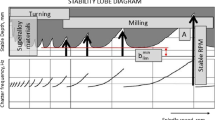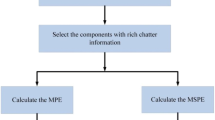Abstract
On-line detection of chatter is one of the key techniques to avoid the harmful effects caused by chatter in grinding process. The key to chatter detection is to capture reliable chatter features and thresholds. To achieve this, it is important to make clear and extract the essential characteristics of the grinding chatter signal, which has not yet been well studied. In this paper, we are going to investigate the essential characteristics of the grinding chatter signal and propose a new approach for on-line detection of grinding chatter. The proposed approach for on-line detection of grinding chatter is based on minimum entropy deconvolution and autocorrelation function, in which the minimum entropy deconvolution is employed to deconvolve the effect of transmission path, and further to restore the essential characteristics of the chatter signals. To eliminate the interference of the non-periodic impulse signals in the measured vibration signals, an autocorrelation function is introduced. Kurtosis is employed to indicate chatter according to the changes of the processed signal. The validity of the proposed method is demonstrated through the measured vibration signals obtained from grinding processes and the presented chatter detection index is independent from the grinding conditions with excellent detection accuracy and permissible computational efficiency. This demonstrates the effectiveness of proposed method in on-line implementation.















Similar content being viewed by others
Data availability
Our data was acquired from Qinchuan Machine Tool Group Co., Ltd. China. We signed a confidentiality agreement, so we are very sorry that the test data cannot be shared.
References
Kondo E, Ota H, Kawai T (1997) A new method to detect regenerative chatter using spectral analysis, Part 1: basic study on criteria for detection of chatter. J Manuf Sci Eng 119(4A):461–466. https://doi.org/10.1115/1.2831175
Caixu Y, Haining G, Xianli L, Liang SY, Lihui W (2019) A review of chatter vibration research in milling. Chin J Aeronaut 2(32):215–242. https://doi.org/10.1016/j.cja.2018.11.007
Govekar E, Baus A, Gradišek J, Klocke F, Grabec I (2002) A new method for chatter detection in grinding. CIRP Ann 1(51):267–270. https://doi.org/10.1016/S0007-8506(07)61514-5
Fu Y, Zhang Y, Zhou H, Li D, Liu H, Qiao H, Wang X (2016) Timely online chatter detection in end milling process. Mech Syst Signal Process 75:668–688. https://doi.org/10.1016/j.ymssp.2016.01.003
Kuljanic E, Sortino M, Totis G (2008) Multisensor approaches for chatter detection in milling. J Sound Vib 4–5(312):672–693. https://doi.org/10.1016/j.jsv.2007.11.006
Liu Y, Wang X, Lin J, Zhao W (2016) Early chatter detection in gear grinding process using servo feed motor current. Int J Adv Manuf Technol 9–12(83):1801–1810. https://doi.org/10.1007/s00170-015-7687-9
Li Y, Zhou S, Lin J, Wang X (2017) Regenerative chatter identification in grinding using instantaneous nonlinearity indicator of servomotor current signal. Int J Adv Manuf Technol 1–4(89):779–790. https://doi.org/10.1007/s00170-016-9117-z
Liu Y, Wang X, Lin J, Zhao W (2016) Correlation analysis of motor current and chatter vibration in grinding using complex continuous wavelet coherence. Meas Sci Technol 27:115106. https://doi.org/10.1088/0957-0233/27/11/115106
Griffin JM, Chen X (2009) Multiple classification of the acoustic emission signals extracted during burn and chatter anomalies using genetic programming. Int J Adv Manuf Technol 11(45):1152–1168. https://doi.org/10.1007/s00170-009-2026-7
Cao H, Zhou K, Chen X (2015) Chatter identification in end milling process based on EEMD and nonlinear dimensionless indicators. Int J Mach Tools Manuf 92:52–59. https://doi.org/10.1016/j.ijmachtools.2015.03.002
Gradišek J, Govekar E, Grabec I (1998) Using coarse-grained entropy rate to detect chatter in cutting. J Sound Vib 5(214):941–952. https://doi.org/10.1006/jsvi.1998.1632
Gradišek J, Baus A, Govekar E, Klocke F, Grabec I (2003) Automatic chatter detection in grinding. Int J Mach Tools Manuf 14(43):1397–1403. https://doi.org/10.1016/S0890-6955(03)00184-6
Quintana G, Ciurana J (2011) Chatter in machining processes: a review. Int J Mach Tools Manuf 5(51):363–376. https://doi.org/10.1016/j.ijmachtools.2011.01.001
Altintas Y, Weck M (2004) Chatter stability of metal cutting and grinding. CIRP Ann 2(53):619–642. https://doi.org/10.1016/S0007-8506(07)60032-8
Li H, Shin YC (2006) Wheel regenerative chatter of surface grinding. J Manuf Sci Eng 2(128):393–403. https://doi.org/10.1115/1.2137752
Insperger T, Stépán G, Bayly P, Mann B (2003) Multiple chatter frequencies in milling processes. J Sound Vib 2(262):333–345. https://doi.org/10.1016/S0022-460X(02)01131-8
Wiggins RA (1978) Minimum entropy deconvolution. Geoexploration 1–2(16):21–35. https://doi.org/10.1016/0016-7142(78)90005-4
Endo H, Randall R (2007) Enhancement of autoregressive model based gear tooth fault detection technique by the use of minimum entropy deconvolution filter. Mech Syst Signal Process 2(21):906–919. https://doi.org/10.1016/j.ymssp.2006.02.005
Jiang R, Chen J, Dong G, Liu T, Xiao W (2013) The weak fault diagnosis and condition monitoring of rolling element bearing using minimum entropy deconvolution and envelop spectrum. Proc Inst Mech Eng C J Mech Eng Sci 5(227):1116–1129. https://doi.org/10.1177/0954406212457892
Dan H, Wang X, Li S, Jing L, Ming Z (2016) Identification of multiple faults in rotating machinery based on minimum entropy deconvolution combined with spectral kurtosis. Mech Syst Signal Process Dec 81:235–249. https://doi.org/10.1016/j.ymssp.2016.03.016
Randall RB, Antoni J (2011) Rolling element bearing diagnostics—a tutorial. Mech Syst Signal Process 2(25):485–520. https://doi.org/10.1016/j.ymssp.2010.07.017
Mcdonald GL, Zhao Q, Zuo MJ (2012) Maximum correlated Kurtosis deconvolution and application on gear tooth chip fault detection. Mech Syst Signal Process 33:237–255. https://doi.org/10.1016/j.ymssp.2012.06.010
Balanda KP, MacGillivray H (1988) Kurtosis: a critical review. Am Stat 2(42):111–119. https://doi.org/10.2307/2684482
Li X, Wan S, Huang X, Hong J (2020) Milling chatter detection based on VMD and difference of power spectral entropy. Int J Adv Manuf Technol 7(111):2051–2063. https://doi.org/10.1007/s00170-020-06265-y
Funding
This research is supported by Xi’an Key Laboratory of Modern Intelligent Textile Equipment (Grant No. 2019220614SYS021CG043), and the Natural Science Foundation of Shaanxi Province, China (Grant No. 2020JQ-820).
Author information
Authors and Affiliations
Contributions
All authors contributed to the study conception and design. Material preparation, data collection, and analysis were performed by Dan He, Zexing Ni, and Xiufeng Wang. The first draft of the manuscript was written by Dan He and all authors commented on previous versions of the manuscript. All authors read and approved the final manuscript.
Corresponding author
Ethics declarations
Competing interests
The authors declare no competing interests.
Additional information
Publisher's note
Springer Nature remains neutral with regard to jurisdictional claims in published maps and institutional affiliations.
Rights and permissions
About this article
Cite this article
He, D., Ni, Z. & Wang, X. Online grinding chatter detection based on minimum entropy deconvolution and autocorrelation function. Int J Adv Manuf Technol 120, 6175–6185 (2022). https://doi.org/10.1007/s00170-022-09137-9
Received:
Accepted:
Published:
Issue Date:
DOI: https://doi.org/10.1007/s00170-022-09137-9




